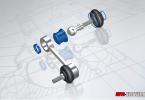Cars equipped with an automatic transmission are distinguished by a high level of driving comfort, but due to the complexity of the structural structure, the automatic transmission requires more attention from the car owner than a mechanic. To care for the box, special ATF (Automatic Transmission Fluid) lubricants are used, which ensure the stability of the device. Transmission fluids for automatic transmissions perform not only the function of lubrication and protection of mechanisms from friction, but also heat removal and removal of wear particles. Over time, ATF loses its properties and the box requires. This rule applies to all types of devices, regardless of manufacturer. The oil change in the automatic transmission of Nissan cars is carried out even if the automaker has filled in liquid for the entire service life of the box, because not only kilometers of run, but also operating conditions, affect the degree of lubricant aging.
The key feature of changing oil in Nissan automatic transmissions is the use of an original lubricant.
When to change oil in automatic transmission on Nissan
Fluid change intervals for automatic transmissions of Nissan cars are 60 - 70 thousand kilometers. At the same time, the manufacturer assumes normal operating conditions, heavy loads on the machine significantly increase the wear of the lubricant composition, reducing the service life of the product by almost half. When buying a car on the secondary market, it is recommended to immediately replace the ATF in the box, after which you can carry out subsequent procedures, following the maintenance schedule. It is necessary to change the oil in the Nissan automatic transmission earlier if, when checking the level and condition of the fluid, traces of wear of parts were found, the lubricant became cloudy or exudes a burnt odor. Interruptions in the operation of the box may also indicate a lack of lubricant composition or the need to replace it. In order to timely identify signs of ATF aging, it is necessary to regularly check the fluid level, and at the same time monitor the condition of the lubricant.
Characteristics of oils for the Nissan box
For automatic transmissions, synthetic or semi-synthetic compounds are used that are of high quality and meet the requirements of the automaker. Nissan gear oil forms a strong protective film on the surface of the gearbox contacting elements and has anti-seize properties. The characteristics of fluids are determined by the SAE viscosity parameters and the API grading system. The lettering values HD or EP indicate the enhanced extreme pressure properties of the formulation.
Winter products have SAE 84W, 80W and 75W ratings, summer oils are designated SAE140 and SAE 90, all-season oils - SAE 85 (80 or 90) W-140. According to the API parameter, lubricants are classified due to the structural structure of the gearbox.
Description of Nissan transmission fluids:
- original product NISSAN Matic Fluid D is used for automatic transmissions and power steering systems;
- NISSAN Matic Fluid J - oil for automatic transmissions of the latest generation Nissan;
- NISSAN NS-1 and NS-2 - fluids for CVT type gearboxes;
- NISSAN LSD GL-5 80W-90 - transmission oil for use in cars with hyperboloid gears and differentials;
- GL-4 MT-XZ GEAR SPORT is a lubricant for manual transmissions.

All formulations have different characteristics and purposes, the manufacturer recommends each of them for different types of transmission. Features of NISSAN brand products allow you to maximize the protection of parts in an automatic transmission, variator or mechanics. An alternative for the gearbox of Nissan cars can be high quality products of other brands that meet the same requirements.
What is needed
For work on it is necessary to prepare the following tools and consumables:
- recommended original ATF;
- new oil filter;
- pallet gasket;
- a set of keys, a screwdriver;
- WD40 cleaning fluid;
- funnel or syringe for filling oil;
- clean rags, gloves;
- 2 hoses (if it is decided to carry out a complete replacement yourself);
- container for collecting mining.
There are two options: full and partial. When carrying out the procedure by the method of complete replacement, the system is flushed, and the liquid is completely displaced, being replaced by a new one by 100%. This option is not always advisable and not recommended for some car models. Partial replacement is more likely to renew the oil, because the old fluid is not completely drained, some of it remains in the channels and the torque converter. To change the lubricant as much as possible in this way, you will need to repeat 3 - 4 procedures after a short run.
Partial oil change
The most economical and safest way for the box is to partially update it. The procedure is simple, does not require special skills from the performer and looks like this:

We carry out a complete replacement with our own hands
For 100% fluid replacement, special equipment is usually used. The process is carried out in a car service with the connection of a device that automatically squeezes out the old grease from the gearbox, then replacing it with a new one. Some motorists carry out this version of the procedure on their own. Of course, with self-fluid replacement, the results can be completely unpredictable, so the motorist takes full responsibility for the possible consequences. It is better to carry out the procedure with an assistant. For the purpose, it is necessary to perform the following actions:
- We do everything the same as for a partial update, then, pouring oil into the automatic transmission, disconnect the oil drain pipes from the cooling radiator.
- We put on the hoses, lower them into the prepared container, where the liquid will be drained.
- We start the engine and watch the oil flowing out. The procedure lasts until the lubricant takes on a fresh look, completely renewed, after which the motor is turned off.
- We remove the hoses, return the tubes to their place.
- We check the level against the cold and hot marks on the dipstick.

When carrying out a complete replacement, a double or even triple volume of oil is used, so the method does not differ in cheapness. In addition, in some Nissan models it is highly discouraged to carry out this kind of replacement, since the procedure can lead to irreparable consequences for the box.
Functions of ATF oil in automatic transmission Nissan Expert:
- effective lubrication of rubbing surfaces and mechanisms;
- reduction of the mechanical load on the units;
- heat removal;
- removal of microparticles formed due to corrosion or wear of parts.
- wear of automatic transmission oil seals;
- wear of the surfaces of the shafts, the occurrence of a gap between the shaft and the sealing element;
- wear of the automatic transmission sealing element and the speedometer drive shaft;
- play in the input shaft of the automatic transmission;
- damage to the sealing layer in the joints between the automatic transmission parts: pallet, automatic transmission housing, crankcase, clutch housing;
- loosening of the bolts that ensure the connection of the above parts of the automatic transmission;
Due to a lack of oil or low-quality oil in the Nissan Expert automatic transmission:
- plungers and channels of the valve body are clogged with mechanical particles, which leads to a shortage of oil in the packages and provokes wear of the sleeve, rubbing parts of the pump, etc.;
- steel transmission discs overheat and wear out quickly;
- rubberized pistons, thrust discs, clutch drum, etc; overheat and burn out;
- the valve body wears out and becomes unusable.
You can check the oil level in the Nissan Expert automatic transmission using a dipstick. The oil dipstick has two pairs of marks - the upper pair Max and Min allows you to determine the level on hot oil, the bottom pair - on cold oil. Using the dipstick, it is easy to check the condition of the oil: you need to drip oil onto a clean white cloth.
When choosing a Nissan Expert automatic transmission oil for replacement, you should be guided by a simple principle: it is best to use an oil recommended by Nissan. In this case, instead of mineral oil, you can fill in semi-synthetic or synthetic, but in no case should you use oil "lower class" from the prescribed one.
Synthetic oil for automatic transmission Nissan Expert is called "irreplaceable", it is poured for the entire service life of the car. Such oil does not lose its properties under the influence of high temperature and is designed for a very long period of use Nissan Expert. But we must not forget about the appearance of mechanical suspension as a result of wear of the clutches with a very significant mileage. If the automatic transmission has been operated for some time in conditions of a lack of oil, it is required to check the degree of its contamination and, if necessary, replace it.
Ways to change the oil in the automatic transmission Nissan Expert:
- Partial oil change in the Nissan Expert box;
- Complete oil change in the Nissan Expert box;
A complete oil change of the Nissan Expert automatic transmission is carried out using an oil change unit in an automatic transmission, by specialists in the car service. In this case, more ATF oil will be required than the Nissan Expert automatic transmission can accommodate. One and a half or double volume of fresh ATF is used for flushing. The cost will be more expensive than partial replacement, and not every car service provides such a service.
Partial ATF oil change in Nissan Expert automatic transmission box according to a simplified scheme:
- Unscrew the drain plug, drain the old ATF oil;
- We unscrew the automatic transmission pan, which, in addition to the bolts holding it, is processed along the contour with a sealant.
- We get access to the automatic transmission filter, it is advisable to change it with each oil change, or rinse it.
- At the bottom of the pallet there are magnets that are necessary for collecting metal dust and shavings.
- We clean the magnets and rinse the pan, wipe dry.
- Install the automatic transmission filter in place.
- We install the automatic transmission pan in place, replacing the automatic transmission pan gasket if necessary.
- We tighten the drain plug, replacing the drain plug gasket for the automatic transmission.
The oil in the automatic transmission (automatic gearbox) performs the functions of lubricating various elements, maintaining the desired temperature in the system, as well as a number of other functions. It is absolutely certain that the automatic transmission is one of the most important units in a modern car. It should also be noted that repairing an automatic transmission is not a cheap pleasure, so you should take care of its maintenance in advance.
It is not surprising that transmission oil, like engine oil, loses its properties over time: it accumulates wear products, additives contained in the oil are produced, and in severe frost, the oil in the box can simply freeze. As a result, the gearbox can fail without a chance for repair. In general, if you do not change the oil in a timely manner and aggressively operate the car, the consequences can be extremely serious and costly.
When to change oil in automatic transmission on Nissan
The car manufacturer Nissan recommends an oil change every 60,000 km. It often happens that the motorist does not make a replacement after the first 60-120 thousand km, respectively, the next replacement is assumed when crossing the mark of 180 thousand km. mileage, but by this time at least a quarter of the oil volume in the system is absolutely not suitable for work. That is why problems with the gearbox begin to arise after 200 thousand km. mileage.
Maintenance regulations for changing the oil in an automatic transmission
З - oil change in automatic transmission
| Automobile model | Mileage thousand km. | 15 | 30 | 45 | 60 | 75 | 90 | 105 | 120 | 135 | 150 | 165 | 180 | 195 | 210 |
| Month | 12 | 24 | 36 | 48 | 60 | 72 | 84 | 96 | 108 | 120 | 132 | 144 | 156 | 168 | |
| Almera N16 (automatic transmission) | Z | Z | Z | ||||||||||||
| Almera classic B10 (automatic transmission) | Z | Z | Z | ||||||||||||
| Micra K12 (automatic transmission) | Z | Z | Z | ||||||||||||
| Note E11 HR (automatic transmission) | Z | Z | Z | ||||||||||||
| Primera P12 QG (automatic transmission) | Z | Z | Z | ||||||||||||
| Tiida C11 HR12 (automatic transmission) | Z | Z | Z | ||||||||||||
| Maxima A33 (automatic transmission) | Z | Z | Z | ||||||||||||
| Juke F15 (automatic transmission) | Z | Z | Z | ||||||||||||
| Teana J31 (automatic transmission) | Z | Z | Z | ||||||||||||
| Quashqai Q10 (automatic transmission) | Z | Z | Z | ||||||||||||
| Murano Z50 / Z51 (automatic transmission) | Z | Z | Z | ||||||||||||
| Navara D40 (automatic transmission) | Z | Z | Z | ||||||||||||
| Pathfinder R51 (automatic transmission) | Z | Z | Z | ||||||||||||
| Patrol Y61 (automatic transmission) | Z | Z | Z | ||||||||||||
| X-Trail T30 / T31 (automatic transmission) | Z | Z | Z | ||||||||||||
| Terrano R20 / F15 (automatic transmission) | Z | Z | Z |
Partial and complete oil change
There are two options for replacement: partial and complete. Partial replacement is when the oil is changed by means of ordinary draining and filling with a new one, but at the same time, only about half of the total volume of oil changes in the system, because the rest remains in the torque converter, clutch housing and a number of other components. This can be critical for the further proper operation of the transmission.
A complete oil change is performed using special equipment. As a result, all oil is pumped out of the system, the system is flushed and new oil is filled. It is fair to say that the replacement procedure is best done in a specialized car service.
If you decide on a partial oil change, then you will need an average of 5 liters of oil. But the frequency of partial oil changes will need to be increased so that the old used oil leaves the system (every 30 thousand km.). In the event of a complete oil change, about 10 liters will be needed.
Together with the oil, you can change the filter, but this is not very necessary, and for various reasons, such a replacement can be extremely time consuming. Therefore, it is better to carry out this work in a service center.
Partial oil change in automatic transmission Nissan do it yourself
We will demonstrate the process of changing the oil in an automatic transmission using the example of Nissan Maxima
1. Jack up the vehicle or use a pit. The picture below shows the location of the transmission oil drain hole, as well as the bolts for removing the sump, under which the filter is hidden. With a partial oil change, the filter does not need to be changed, therefore, it is also not worth removing the sump in this case.

2. Put on gloves, place a container under the drain hole, where the oil will be drained. Take the key on "19" and slightly unscrew the drain plug. Then unscrew the plug completely by hand. The oil will immediately start to drain and run down your hand, which is why you need to wear gloves.

3. When the oil has drained out, it is necessary to check how many liters have been drained. As we wrote above, with a partial replacement, about half of the total volume merges. To find out the volume of the drained oil, simply pour it into a bottle or some other container of which you know the volume.

4. Once you know how much oil has drained, remove the dipstick from the filler hole, place a funnel there and pour in the same volume of new gear oil.

5. Insert the dipstick back. Now you need to start the car and wait 5 minutes. After that, sequentially change all gears from P to 2 and back to P. Maintain the interval between gear changes in 2-3 seconds. Then get out of the car and check the oil level with the dipstick. Top up if necessary.

This is how the automatic transmission oil in Nissan cars is changed.
To completely change the oil in the automatic transmission, you should contact the service center, where they will be replaced with special equipment.
- Matic Fluid j - for cars of the domestic, Japanese, market.
- Matic Fluid d - For cars of the European and American markets, as well as NCVT variators (compatible with Dexron III).
- Matic Fluid s - Only for 5-speed rear-wheel drive automatic transmissions.
- Dexron III is Fluid d compatible and recommended for partial, but incomplete, oil changes in the box.
In some boxes, only a partial oil change is recommended. In the checkpoint there are about 7-8 liters, of which 4-5 are drained and a new one is poured. You can independently make only a partial oil change in the box, a complete replacement of the transmission oil in the Nissan automatic transmission is carried out using a special apparatus by means of replacement. For both options, it is recommended to immediately change the oil filter and sump gasket.
To partially change the oil in the automatic transmission of a Nissan car, you need to raise the car or find an inspection hole. We unscrew the automatic transmission drain plug, substituting the container for the used oil in advance. When the oil drains, it is necessary to unscrew the gearbox pan, then some more oil will drain, clean the pan and change the filter. You can put everything in place, after installation, add lubricating fluid to the box through the neck on the crankcase. We start the engine and change gears, at the end of manipulations with the box, check the oil level, top up or drain the excess if necessary.
In the case of a complete (hardware) replacement, everything happens the same way, but until the moment of refilling. At that moment, when you need to add oil, the device turns on. It is connected to the pipes connecting the box with the radiator, the internal combustion engine and the device are started. The new substance begins to move through the system, displacing the old one. The device carries out replacement in a circular way, and has two indicators showing the color of the fluid entering and leaving the system. When new oil starts to come out of the system, then the replacement process will be completed.
NOTE! Dextron is not a manufacturer's brand, but an oil classification. Its creators are General Motors; today, various brands are produced under this marking. Many automakers list the recommended oil on the dipstick, or under the hood of an internal combustion engine.
If you fill in ATF that does not meet the requirements of your box, then, as a result, the transmission will not be able to work to its full extent, since an incorrectly selected fluid can even increase the wear of parts. Do not assume that the higher the oil classification, the better. For example, Dexron 5 can significantly slow down the operation of a car, in the recommendations for which a 3rd generation fluid is indicated.
Oil change period in automatic transmission Nissan
Nissan automatic transmission oil “does not need to be changed” - so the manufacturer says, but it can be replaced if the car is operated in difficult conditions. Light conditions are considered to be movement in which the box is loaded to a minimum. City mode with traffic jams and traffic lights refers to intensive driving, forcing the box to constantly change gears. In this case, the oil must be changed between 60,000 and 90,000 km, depending on the vehicle model. The exact figure is indicated in the instruction manual.
IMPORTANT! If, when switching, the box began to "kick", an urgent, extraordinary replacement of the lubricating fluid is necessary.
- It is better to change ATF completely, that is, in a hardware way. With a partial replacement, chips and emulsion deposits are retained in the transmission.
- You can mix synthetics and semi-synthetics without consequences. Unlike an internal combustion engine, the box will not pay attention to the mixture.
- Fill only with the oil recommended by the car manufacturer. In addition to the commercial component, the recommendations are also technical in nature.
- Do not exceed the oil level and avoid oil starvation. This can lead to failure of the box or a rapid decrease in the resource of parts.
- If negative changes are observed in the operation of the box, it is also worth replacing the fluid. The oil in the automatic transmission performs a number of important functions, so any change in gear shifting can be caused precisely by the ATF.
- Do not neglect or postpone servicing the transmission, oil problems can cause serious deterioration in transmission performance. Even a partial replacement can significantly improve the situation, but it is, of course, better to completely replace the fluid.
The transmission oil also acts as a cooling function in the box. A low oil level can lead to overheating of the gearbox, reduce its resource, or even one of the gears can disappear. An elevated oil level can make your gearbox one notch less and also cause the oil to foam and blow out through the gearbox breather.




